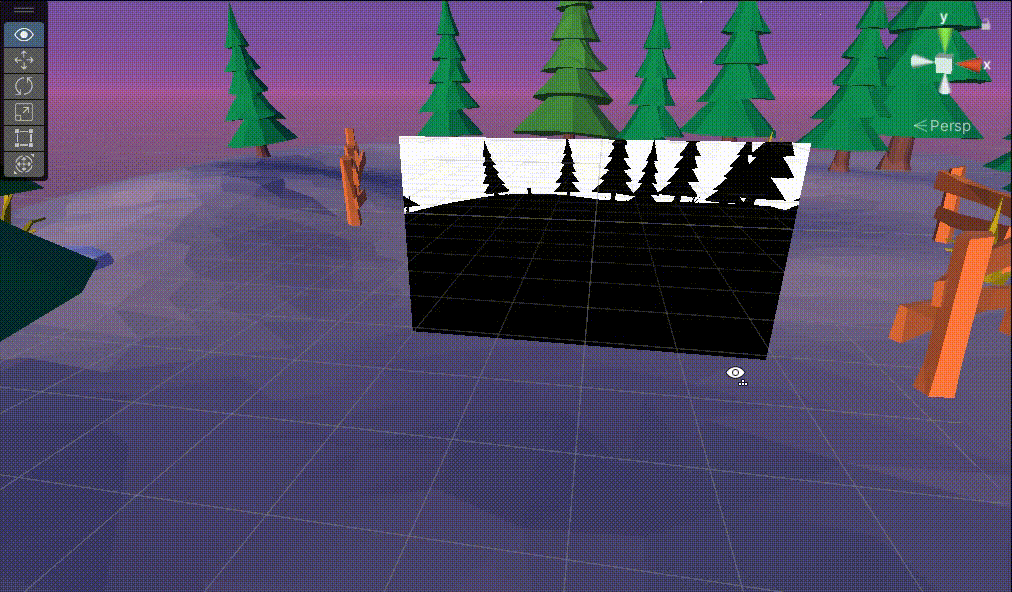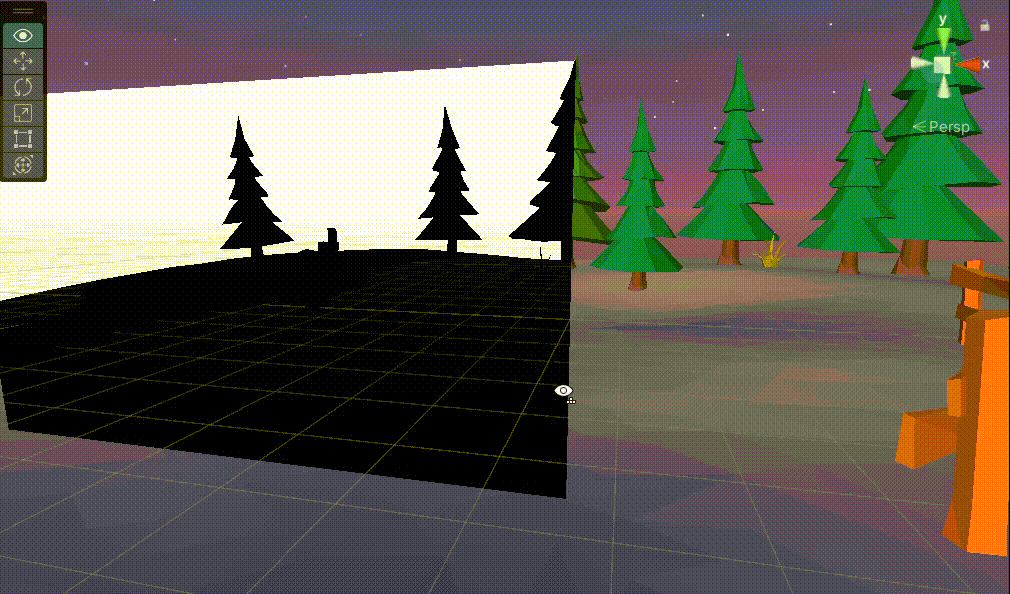Unity中URP下使用屏幕坐标采样深度图
文章目录
前言
在上一篇文章中,我们实现了URP下深度图的使用。
但是,因为是使用模型UV采样的原因。所以,深度图效果不对

所以,在这一篇文章中,我们使用屏幕坐标来采样深度图。
一、Unity使用了ComputeScreenPos函数得到屏幕坐标
1、 我们来看一下这个函数干了什么

齐次裁剪空间进行透视除法
- x n d c = x w x_{ndc} = \frac{x}{w} xndc?=wx?
然后进行如下步骤,化简得到该函数结果
- x s c r e e n = ( x n d c ? 0.5 + 0.5 ) ? w i d t h x_{screen} = (x_{ndc}*0.5+0.5)*width xscreen?=(xndc??0.5+0.5)?width
- x s c r e e n = ( x w ? 0.5 + 0.5 ) ? w i d t h x_{screen} = (\frac{x}{w}*0.5+0.5)*width xscreen?=(wx??0.5+0.5)?width
- x s c r e e n w i d t h = ( x w ? 0.5 + 0.5 ) \frac{x_{screen}}{width}=(\frac{x}{w}*0.5+0.5) widthxscreen??=(wx??0.5+0.5)
- x s c r e e n w i d t h ? w = ( x ? 0.5 + w ? 0.5 ) \frac{x_{screen}}{width}*w=(x*0.5+w*0.5) widthxscreen???w=(x?0.5+w?0.5)
2、我们看一下该函数实现该结果的意义
x s c r e e n w i d t h ? w \frac{x_{screen}}{width}*w widthxscreen???w
-
当 x s c r e e n = 0 x_{screen} = 0 xscreen?=0
x s c r e e n w i d t h ? w = 0 \frac{x_{screen}}{width}*w = 0 widthxscreen???w=0 -
当 x s c r e e n = w i d t h x_{screen} =width xscreen?=width
x s c r e e n w i d t h ? w = w \frac{x_{screen}}{width}*w = w widthxscreen???w=w -
得到最终o的范围
-
( [ 0 , w ] , [ 0 , w ] , z , w ) ([0,w],[0,w],z,w) ([0,w],[0,w],z,w)
-
( [ 0 , w ] w , [ 0 , w ] w , z w , 1 ) (\frac{[0,w]}{w},\frac{[0,w]}{w},\frac{z}{w},1) (w[0,w]?,w[0,w]?,wz?,1)
-
( [ 0 , 1 ] , [ 0 , 1 ] , z w , 1 ) ([0,1],[0,1],\frac{z}{w},1) ([0,1],[0,1],wz?,1)
二、在Shader中使用(法一)
1、在Varying结构体中
float4 screenPos : TEXCOORD1;
2、在顶点着色器中
o.screenPos = ComputeScreenPos(o.positionCS);
3、在片元着色器中
float2 uv = i.screenPos.xy / i.screenPos.w;
float4 cameraDepthTex = SAMPLE_TEXTURE2D(_CameraDepthTexture,sampler_CameraDepthTexture,uv);
float depthTex = Linear01Depth(cameraDepthTex,_ZBufferParams);
return depthTex;
三、在Shader中使用(法二)
- 原理:用 齐次裁剪坐标 屏幕宽高 \frac{齐次裁剪坐标} {屏幕宽高} 屏幕宽高齐次裁剪坐标?刚好得到[0,1]之间的屏幕uv坐标
1、在片元着色器中
float2 uv = i.positionCS/ _ScreenParams.xy;
float4 cameraDepthTex = SAMPLE_TEXTURE2D(_CameraDepthTexture,sampler_CameraDepthTexture,uv);
float depthTex = Linear01Depth(cameraDepthTex,_ZBufferParams);
return depthTex;
四、最终效果

Shader "MyShader/URP/P4_1"
{
Properties
{
_Color("Color",Color) = (0,0,0,0)
_MainTex("MainTex",2D) = "white"{}
}
SubShader
{
Tags
{
//告诉引擎,该Shader只用于 URP 渲染管线
"RenderPipeline"="UniversalPipeline"
//渲染类型
"RenderType"="Transparent"
//渲染队列
"Queue"="Transparent"
}
//Blend One One
ZWrite Off
Pass
{
Name "Unlit"
HLSLPROGRAM
#pragma vertex vert
#pragma fragment frag
// Pragmas
#pragma target 2.0
// Includes
#include "Packages/com.unity.render-pipelines.core/ShaderLibrary/Color.hlsl"
#include "Packages/com.unity.render-pipelines.universal/ShaderLibrary/Core.hlsl"
#include "Packages/com.unity.render-pipelines.universal/ShaderLibrary/Input.hlsl"
CBUFFER_START(UnityPerMaterial)
half4 _Color;
CBUFFER_END
//纹理的定义,如果是编译到GLES2.0平台,则相当于sample2D _MainTex;否则相当于 Texture2D _MainTex;
TEXTURE2D(_MainTex);SAMPLER(SamplerState_linear_mirrorU_ClampV); float4 _MainTex_ST;
TEXTURE2D(_CameraDepthTexture);SAMPLER(sampler_CameraDepthTexture);
//struct appdata
//顶点着色器的输入
struct Attributes
{
float3 positionOS : POSITION;
float2 uv : TEXCOORD0;
};
//struct v2f
//片元着色器的输入
struct Varyings
{
float4 positionCS : SV_POSITION;
float2 uv : TEXCOORD0;
float4 screenPos : TEXCOORD1;
};
//v2f vert(Attributes v)
//顶点着色器
Varyings vert(Attributes v)
{
Varyings o = (Varyings)0;
float3 positionWS = TransformObjectToWorld(v.positionOS);
o.positionCS = TransformWorldToHClip(positionWS);
o.uv = TRANSFORM_TEX(v.uv,_MainTex);
o.screenPos = ComputeScreenPos(o.positionCS);
return o;
}
//fixed4 frag(v2f i) : SV_TARGET
//片元着色器
half4 frag(Varyings i) : SV_TARGET
{
half4 c;
float4 mainTex = SAMPLE_TEXTURE2D(_MainTex,SamplerState_linear_mirrorU_ClampV,i.uv);
//c = _Color * mainTex;
//深度图
//float2 uv = i.screenPos.xy / i.screenPos.w;
float2 uv = i.positionCS/ _ScreenParams.xy;
float4 cameraDepthTex = SAMPLE_TEXTURE2D(_CameraDepthTexture,sampler_CameraDepthTexture,uv);
float depthTex = Linear01Depth(cameraDepthTex,_ZBufferParams);
return depthTex;
}
ENDHLSL
}
}
FallBack "Hidden/Shader Graph/FallbackError"
}
本文来自互联网用户投稿,该文观点仅代表作者本人,不代表本站立场。本站仅提供信息存储空间服务,不拥有所有权,不承担相关法律责任。 如若内容造成侵权/违法违规/事实不符,请联系我的编程经验分享网邮箱:chenni525@qq.com进行投诉反馈,一经查实,立即删除!
- Python教程
- 深入理解 MySQL 中的 HAVING 关键字和聚合函数
- Qt之QChar编码(1)
- MyBatis入门基础篇
- 用Python脚本实现FFmpeg批量转换
- Tiktok怎样多开不封号?海外云手机就能解决!
- Neo4j数据库自动启停与定时备份
- 椋鸟C语言笔记#29:联合体、枚举类型
- React面试题:React.Component和React.PureComponent的区别?
- CentOS7安装Neo4j
- 在电脑上免费压缩视频的 16 个视频压缩软件
- 关于库函数和自定义函数
- 力扣刷题记录(24)LeetCode:53、392、115
- 【前端基础】script引入资源脚本加载失败解决方案(重新加载获取备用资源)
- SSH:关键组件Kex, HostKey, HMAC算法及其用途